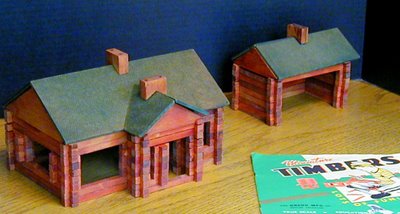
Just before I shut down & went to bed last night, I discovered new plans for Ankerstein Set 6 on Burkhard Schulz's
Anker Bauvorlagen.
The downloadable PDF booklet contains three excellent plans, "
Brücke - Uhr - Leuchtturm" (Bridge - Clock - Lighthouse), by a longtime friend of this site, William Seppeler of
Anchor Stone Constructions.
The plans demonstrate yet again (cf the
Czech Anchor site) that not everything that could be done with Anchor blocks was discovered by the Richter designers a hundred years ago. They also show that one of the key benefits of example designs is seeing ways to use components that one might not come up with on one's own.
Another benefit is of course inspiring one to build.
I began construction before the sun came up this morning.
The third plan, which suggests a harbor entrance watch tower (perhaps Italian?), is particularly compelling. I especially like the stairway turning through the building, and the sandstone arch halves used in two different orientations. And there's just enough of a bridge to win priority over the Bridge design for now.

There is a small error in the level c diagram, where a red stone at left is marked "15" but should be "19." Easily corrected when it becomes evident at the next level or blatantly obvious at the one after.
I'm not sure if this is the designers last hurrah for Set 6, since
his blog has long since left me behind for bigger sets, or if we can hope for future revisits to an old favorite.
My biggest desire in plans is to see more single-box plans (actually, the only ones I've seen have been photos not plans) for the "A" boxes that are officially intended to extend a given set to the next level higher - a 6 plus a 6A makes a Set 8, add an 8A for a Set 10 - but for those of us that more often want quicker Block Play, that means that the smaller sets, the lower numbers, get satisfactory use, while the higher numbers sit neglected.
For just those rare occasions when I might be willing to tackle a three-box Set 10 construction, I can't justify an 8A, but I'd be delighted to have the opportunity to build with the different stone mix and new (to me) stones found in box 8A. That would provide a nice new and different building experience, within the familiar style and linseed-chalk-sand scent of a firm favorite among construction sets.
If you are new to Ankerstein, most folks seem to recommend starting with Set 6, except for smaller children who are better off with a
Heinzelmännchen. I think that for many, set 4, followed by expansion Set 4A, to make a 6 plus a few extra stones, may be a better approach, albeit for more money and with boxes that don't conform to the 6A, etc.
If there is a better place to buy them than
The ToyHouse, I don't know of it, and I'd say that even if I hadn't gotten a few freebie stones and printed materials. Woof. Please mention the Block Play blog.
Always great to be stacking Anker stones again - noting that if I hadn't had them out
a few days ago, it would have taken a lot longer to get myself to try building this.
Good Block Play.
 This bridge is from the K'nex Building Bridges set, which progressively explores a dozen bridge designs. Some of the later ones are more impressive, but I was more interested in making a stereograph than a bridge.
This bridge is from the K'nex Building Bridges set, which progressively explores a dozen bridge designs. Some of the later ones are more impressive, but I was more interested in making a stereograph than a bridge.














